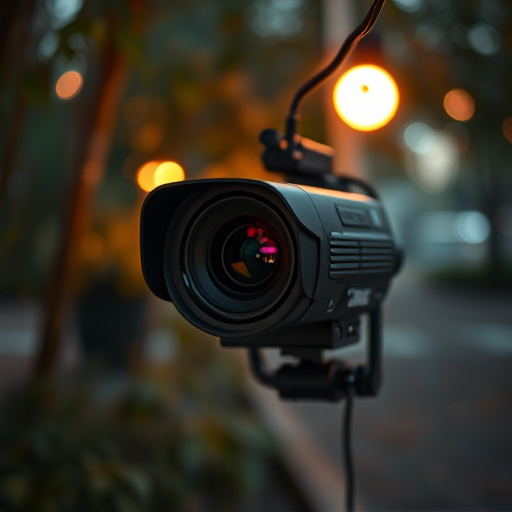Mini surveillance cameras integrated into everyday objects like smoke detectors and artificial plants have become common in today's digital age, offering remote access and real-time monitoring via radio frequency signals. With their compact size, these devices provide landlords and roommates with discreet property security. Radio frequency (RF) detection technology is crucial for pinpointing hidden mini cameras, which operate on specific RF bands. Professional tools like RF detectors and thermal imaging cameras ensure privacy protection by locating and neutralizing covert surveillance threats. However, the use of these cameras raises ethical and legal concerns regarding privacy rights, requiring understanding of local laws governing Mini Surveillance Cameras for Apartments to avoid legal issues.
Uncover the subtle dangers of hidden cameras with our comprehensive guide. Learn how to detect miniature surveillance devices using radio frequency technology, a crucial tool in ensuring privacy in apartments and other spaces. From understanding the microscopic size of these cameras to mastering RF detection methods, this article equips you with knowledge to navigate modern security challenges. Explore ethical considerations and legal frameworks while gaining insights into tools and techniques for locating hidden cameras.
- Understanding Mini Surveillance Cameras: A Brief Overview
- The Science Behind Radio Frequency Detection
- Tools and Techniques for Locating Hidden Cameras
- Ethical Considerations and Legal Aspects of Camera Detection
Understanding Mini Surveillance Cameras: A Brief Overview
Mini surveillance cameras, often referred to as hidden cameras, have become increasingly sophisticated and prevalent in today’s digital era. These tiny devices can be easily integrated into everyday objects like smoke detectors, power outlets, or even artificial plants, making them nearly impossible to detect with the naked eye. They are particularly popular for use in apartments due to their discreteness; landlords or roommates may install these cameras to ensure property security or privacy without raising suspicion among tenants.
With the ability to transmit video signals via radio frequency (RF) signals, mini surveillance cameras offer remote access and real-time monitoring capabilities. This makes it possible for users to keep an eye on their apartments from anywhere at any time through a smartphone app or computer. The compact nature of these devices allows them to fit seamlessly into various environments, making them a popular choice for those seeking discreet security solutions for their homes or businesses.
The Science Behind Radio Frequency Detection
The science behind radio frequency (RF) detection involves pinpointing signals emitted by electronic devices, including hidden surveillance cameras. Mini surveillance cameras for apartments often operate on specific RF bands, making them detectable using specialized equipment. These devices can pick up subtle variations in electromagnetic fields, allowing experts to locate and identify these tiny cameras without causing any disruption.
RF detection techniques leverage the fact that electronics, like camera modules, generate unique signals as they transmit data. By analyzing these signals’ characteristics—frequency, amplitude, and modulation patterns—detectors can precisely track down hidden cameras concealed within walls, ceilings, or other hard-to-reach spaces. This technology ensures privacy protection by enabling professionals to identify and neutralize potential threats posed by covert surveillance devices.
Tools and Techniques for Locating Hidden Cameras
Detecting hidden cameras, particularly in residential settings like apartments, requires a strategic approach and specialized tools. One effective method involves using radio frequency (RF) detectors, which can pick up on signals from mini surveillance cameras often used for covert monitoring. These devices operate by scanning for RF emissions, a signature of many hidden camera systems. By employing an RF detector, individuals can uncover clandestine recording devices hidden within walls, ceilings, or even everyday objects.
Additionally, thermal imaging cameras are valuable assets in the quest to locate these invisible intruders. Thermal technology detects heat signatures, allowing users to identify anomalies that might indicate the presence of a hidden camera. This is especially useful for spotting miniature cameras with minimal power consumption, which can be nearly impossible to detect through conventional means. Combining RF detection and thermal imaging offers a comprehensive strategy for ensuring privacy and peace of mind in apartment environments.
Ethical Considerations and Legal Aspects of Camera Detection
The detection of hidden cameras, particularly miniature surveillance devices in apartments, raises important ethical and legal questions. While it’s crucial to respect privacy rights, tenants or residents have a legitimate interest in knowing if their personal spaces are being invaded by covert recording equipment. This issue intersects with broader discussions on consent, security, and individual freedoms.
Legally, the use of hidden cameras can vary significantly depending on jurisdiction. Some regions have strict regulations regarding video surveillance, mandating clear notification to individuals being recorded. Unauthorized installation or operation of such devices can lead to severe legal consequences. It’s essential for both property owners and tenants to familiarize themselves with local laws pertaining to privacy and surveillance technology, especially when considering the deployment of mini surveillance cameras in apartments.
In the quest to ensure privacy and security, understanding and detecting hidden cameras, particularly mini surveillance cameras in apartments, is an essential skill. This article has provided a comprehensive guide through the science of radio frequency detection, the tools available, and ethical considerations. By equipping individuals with knowledge about these clandestine devices, we can foster a safer environment while respecting privacy rights. Remember that awareness is the first step towards protecting our personal spaces from unwanted intrusion.
